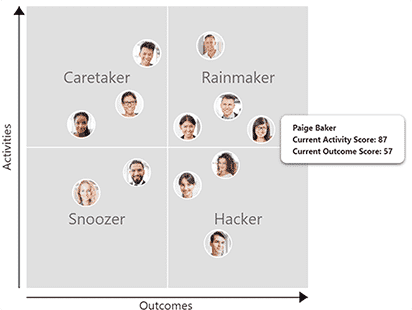5 Tips for Setting the Right Metrics

New Metrics Required.
The eternal puzzle for executives and sales managers is on setting the right metrics to set in order to motivate staff to achieve higher results than in previous years.
Whether it’s the start of a new calendar year or a new financial year staff are wondering what they will be expected to achieve, weekly, monthly, quarterly, and annually. Managers know they can’t rest on their laurels. They will be pondering on setting the right metrics and KPI’s to engage and motivate staff to achieve company goals.
A key part of this process is for managers to review the metrics for the previous year. Did they achieve the expected outcome of driving an increase in sales activities in particular? They will also be looking at what metrics didn’t work, and wondering why? Even if a metric did work, managers must avoid the mistake of thinking that the same metric will work again. Problems change, new people are employed, processes are streamlined and company objectives grow. What was important in previous reporting periods may no longer be sufficient or even in range for the new year.
What Could Possibly Go Wrong?
Metrics are designed to set team members on a specific path. They need to complete business-related activities to achieve the company’s strategic goals for the year. They are not a wish list of outcomes. So in setting the right metrics that will be effective a manager requires a deep understanding of:
- what the company does
- the skills and expertise of the team members
- which activities deliver successful results
- how engaged staff is with the company and their role at the company.
A manager I knew once said, people have to be willing and able in order to deliver the activities and outcomes you need from them to make the business results. He said it’s pretty easy to manage staff if you understand those components and can truthfully apply them to team members:
- If people are willing but not able – they can be trained and coached
- If they are willing and able – celebrate because that’s a great starting position
- If they are able but not willing – they should leave.
Not all data is created equal and to monitor, manage, and reward staff effectively you need to set the correct performance measures and pull data in real-time from a CRM. Immediate performance feedback is invaluable in highlighting self-awareness in a staff member and allowing them to self manage their subsequent behaviors and activity levels.
5 Tips for Better Metric Setting.
Regardless of what you call the “results” you want staff to achieve during their workday, avoiding these common mistakes will ensure better activity completion and better business outcomes.
- Specific – some people think any metric is better than no metric. This is not correct as setting staff on the wrong path can negatively impact the business and lead to disengaged staff. Careful thought needs to be given to understanding what activities and how much of that activity will deliver the best results.
- Clarity – the old adage “keep it simple, sweetie” applies here. Setting the right metrics need to be clear, easily understood, and able to be explained by a staff member back to their manager. By all means have multiple metrics that you measure staff on however keep them as a single activity rather than nested requirements.
- Objectivity – all metrics should be able to be objectively measured. Updating a CRM with a completed activity and immediately displaying this on an office leaderboard means all performance is visible and indisputable.
- Healthily Competitive – people play harder when there is a scoreboard and their performance against the target is being watched. Aberdeen Group found that companies using leaderboards realized a 2X higher year-on-year net income growth and 3X higher year-on-year sales growth than those who didn’t.
- Visible – sunshine is the best disinfectant and visibility of performance on an office TV, for example, drives behavioral change.
Measure the metrics that matter in order to provide the focus for team members. Everyone likes to know where they are going and how to get there. Focusing on the activities that the rep and manager can control also maintains focus. The rep and manager can control their activities that contribute to the sales, such as calls, meetings, and emails, however, it is harder, if not impossible, to control the client’s decision-making process.
How Leaderboards Help.
Leaderboards are an effective way to show an individual their progress against a business activity. A leaderboard is the visualization of staff performance against the business’ key metrics. This transparency of the raw score of activities and more importantly the progress towards the target increases employee productivity.
When staff knows their performance is visible to the entire office, they work harder to make sure their ranking on the leaderboard improves. The very act of keeping score on their progress motivates people to produce better results, be they on lead indicators such as calls, emails or meetings or on lag indicators such as deals won or sales.
The leaderboard can also highlight employees who are doing great work by singling them out from the pack and highlighting their good work. Milestone and target achievements can be celebrated along the way so that individuals and the team feel good about what they are doing. Displaying this information on a TV in the office enables all company stakeholders to be included in the progress of business results and to celebrate with the team.
Keeping track of all staff performance on all leaderboards means you can map your staff in quadrants related to their activities and outcomes in order to see who your star performers are, who needs coaching to higher levels of performance, and who needs counseling about changing roles or changing behaviors. The Spinify Performance Grid comes preloaded with coaching advice.

Conclusion
Data is a science, not a black art. Take sufficient time to really think about the metrics you set, how they align with the company’s strategic objectives, and do some scenario planning on what happens if the metrics are achieved or not achieved. Contingency planning is better than knee jerk reactions during the year.
That said have a tool such as leaderboards allows a manager to run a new metric for a short period, determine the results, and adjust the metric or target as appropriate.
Put those insights into practice.
Set your team up for success by improving their performance through gamification.
Back to blog







